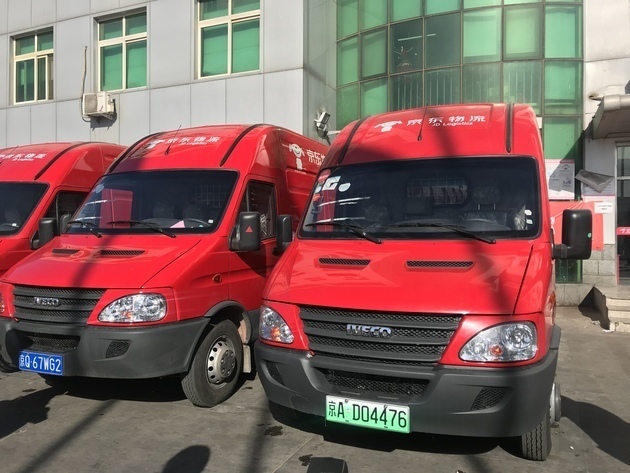Feb.1 (NBD) -- Sustainable development of the e-commerce and delivery sector was first put forward in an official document released by the General Office of the State Council of China last Tuesday.
Richard Liu, chairman and CEO of JD.com (JD), posted on his Weibo account two days after the announcement that his company has put over 700 electric cargo vans into service in Beijing, fulfilling its promise of turning all of its delivery vans electric in Beijing in advance.

Photo/Zhang Si
JD fulfills its green delivery promise
Beijing started to issue car plates designed for new-energy cars from December 28 of last year. Pei Wenbiao, head of the electric cargo van fleet at the company's Tongzhou logistic distributing center, told NBD that JD got its first such car plate on the second day.
JD's electric cargo vans have a range of 180-200 kilometers and can support 2-3 hours of drive. They are quiet and also environmental friendly. So far, the center only has 16 charging piles. Many cars have to be charged by piles owned by others at night.
It's estimated that a fuel car runs 170 kilometers a day on average, consuming 19 liters of oil. The shift to electric car can help reduce 42.74kg in carbon dioxide emission per day. Given JD's employment of 700 electric cargo vans, approximately 11,000 tonnes of carbon dioxide emissions will be reduced.
Liu Jianxin, deputy secretary-general of the China Communications & Transportation Association Express Service Committee, told NBD that the adoption of new-energy cargo vans in the delivery sector is still at the primary stage, and problems such as lacking of supporting devices and high costs need to be addressed. Besides new-energy cargo vans, green packaging is another area that can help create a green delivery system.

Electric delivery van being charged (Photo/Zhang Si)
Sales of new-energy delivery vans to top 60,000 units by 2020
Last year, Cainiao, the delivery unit of Alibaba, launched its smart delivery plan, under which the company expects to release 1 million new-energy cars for logistics jointly with car manufacturers like SAIC Motor and Dongfeng Motor.
According to a report on new-energy delivery cars in China, the sector has seen significant development in recent years. In 2014, there were only 500 units of new-energy delivery vans. Industry insiders said sales of such vans are expected to hit 60,000 units by 2020.
Liu Jianxin noted that the delivery industry in China has seen explosive growth in past years. Solid wastes rose accordingly. To avoid environment pollution, regulators should evaluate delivery companies with certain green indexes, for example, the top 20 percent delivery companies should take the lead in using new-energy cargo vans, Liu added.
Although green delivery is a general trend, the sales of new-energy delivery vans only accounted for a small portion of the total of new-energy vehicles, which may be a combined result of high costs, decreasing subsides, and a shortage of charging piles.
In terms of costs, Liu Fei, head of JD's new-energy delivery car project, told NBD that compared with fuel cars, new-energy delivery vans each will be 30,000 (4,758.51 U.S. dollars) to 40,000 yuan (6,344.67 U.S. dollars) lower in purchase cost. In addition, their maintenance costs and running costs are also lower.
However, as battery technologies keep upgrading all the time, it will add up the costs of new-energy delivery vans, Liu explained.
Meanwhile, issues like lacking of enough charging piles and short endurance time are yet to be improved. This needs the joint efforts of delivery companies, the government and other social sectors, Liu commented.
Email: tanyuhan@nbd.com.cn


 川公网安备 51019002001991号
川公网安备 51019002001991号





